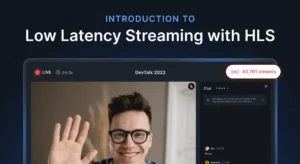
Low Latency Streaming with HLS
We know that HLS can power live streaming. But how quick can it deliver the video to the users? Is low latency streaming possible with HLS? Let’s find out.

If you consume online content (and if you are alive in 2022, you probably do), chances are that you’ve watched quite a few live streams. Be it online classes, sporting events, fitness lessons, or celebrity interactions, live streaming has quickly become the go-to source of learning and entertainment.
Live streamers comprised over 1/3rd of all internet users in March and April 2020, with only 1 in 10 people in the US and UK streaming live content of their own. Just two years since, almost 82% of internet use is expected to be devoted to streaming video by 2022.
A vast majority of live streaming applications are built on a protocol called HTTP Live Streaming, or HLS. In fact, if you’ve ever watched an Instagram live stream or tuned into the Super Bowl on the NBC Sports App, chances are, you’ve been touched by the magical hands of HLS.
So if you are looking to build that kind of sophisticated live streaming experience inside your app, this article should give you a comprehensive understanding of the HLS protocol and everything in it.
Read on to learn the basics of HLS, what it is, how it works, and why it matters for live streamers, broadcasters, and app developers.
HLS stands for HTTP Live Streaming. It is a media streaming protocol designed to deliver audio-visual content to viewers over the internet. It facilitates content transportation from media servers to viewer screens — mobile, desktop, tablets, smart TVs, etc.
Created by Apple, HLS is widely used for distributing live and on-demand media files. For anyone who wants to adaptively stream to Apple devices, HLS is the only option. In fact, if you have an App Store app that offers video content longer than 10 minutes or is heavier than 5MB, HLS is mandatory. You also have to provide one stream, at the very least, that is 64 Kbps or lower.
Bear in mind, however, that even though HLS was developed by Apple, it is now the most preferred protocol for distributing video content across platforms, devices, and browsers. HLS enjoys broad support among most streaming and distribution platforms.
HLS allows you to distribute content and ensure excellent viewing experiences across devices, playback platforms, and network conditions. It is the ideal protocol for streaming video to large audiences scattered across geographies.
HLS was originally created by Apple to stream to iOS and Apple TV devices, Mac on OS X in Snow Leopard, and later OSes.
In the early days of video streaming, Realtime Messaging Protocol (RTMP) was the de-facto standard video protocol for streaming video over the internet. However, with the emergence of HTML5 players that supported only HTTP-based protocols, RTMP became inadequate for streaming.
With the rising dominance of mobile and IoT in the last decade, RTMP took a hit due to its inability to support native playback in these platforms. The Flash Player has to give away ground to HTML5, which resulted in a decline in Flash support across clients. This further contributes to RTMP’s unsuitability for modern video streaming.
HLS is a live streaming protocol that is considered the video delivery “technology of now.”
Compared to progressive videos, HLS avoids re-buffering and stalling effects as well as bloating the client connection. We can see it at work in this video. In essence, HLS provides a much better user experience when we use video content in our apps or sites. It has native support in iOS and Android.

We know that HLS can power live streaming. But how quick can it deliver the video to the users? Is low latency streaming possible with HLS? Let’s find out.

What is HLS? Why is it important for building livestreams? Dive into this beginner’s guide to HLS to learn more.
Video conferencing infrastructure for a video-first world. Quick to integrate native iOS, Android & Web SDKs to add live video & audio conferencing to your applications.
© 100ms, Inc. All rights reserved.